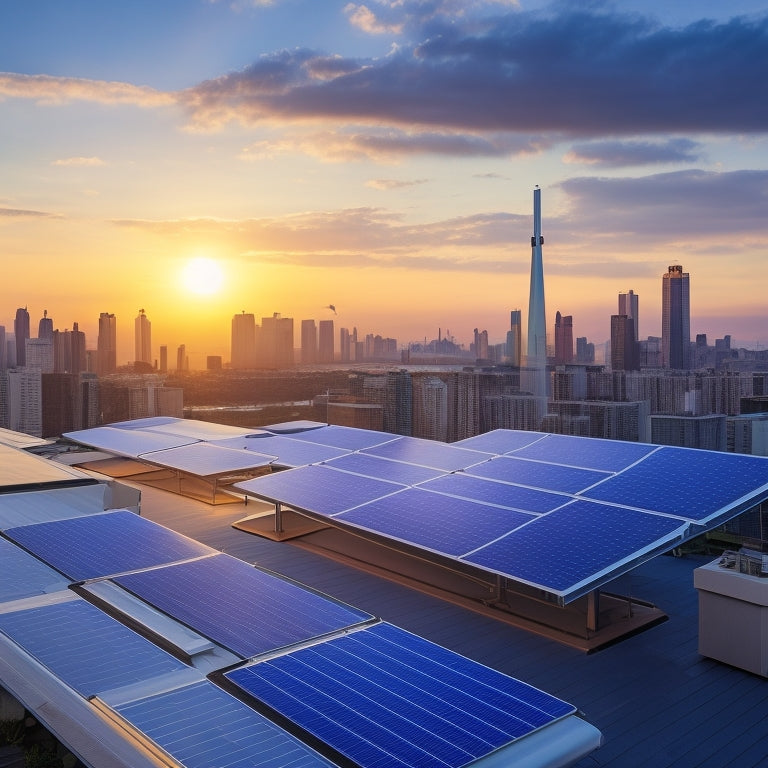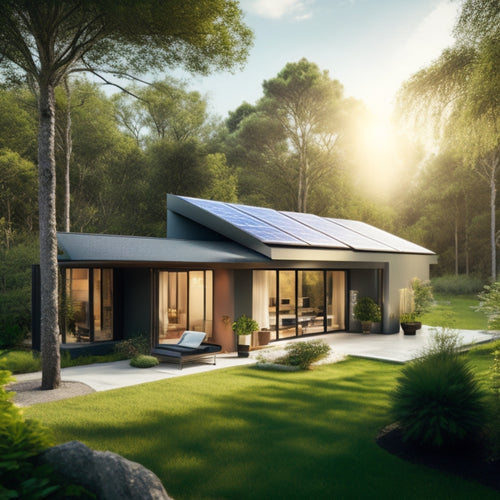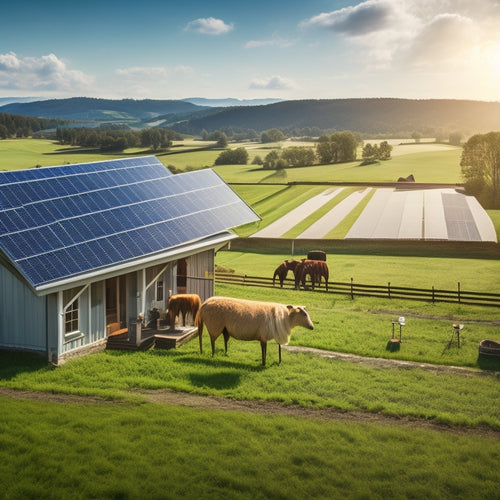
What Are the Latest Advancements in Home Solar Technology?
Share
You're now equipped with the latest home solar technology advancements, including bifacial solar panels that utilize up to 25% more energy and perovskite solar cells boasting power conversion efficiency rates exceeding 23%. High-efficiency solar cells developed recently achieve significant increases in energy conversion rates, while smart solar inverters revolutionize energy capture and usage. You'll also find advanced solar panel materials, building-integrated photovoltaics, and innovations in energy storage and management. As you investigate these state-of-the-art developments, you'll reveal the full potential of home solar technology to maximize your energy independence and savings.
Key Takeaways
- High-efficiency solar panels, such as bifacial and perovskite cells, increase energy output by up to 25% and reduce costs.
- Advanced solar energy storage systems, including lithium-ion batteries, enable homeowners to store excess energy for later use.
- Smart solar inverters with Max Power Point Tracking (MPPT) optimize energy harvesting efficiency and provide real-time monitoring capabilities.
- Innovative materials and technologies, such as thin-film solar cells and building-integrated photovoltaics (BIPV), enhance energy output and aesthetics.
- Real-time monitoring capabilities and data analytics empower homeowners to track energy production and consumption, optimizing energy usage and reducing waste.
Bifacial Solar Panels Explained
As you investigate the latest developments in home solar technology, you'll likely come across bifacial solar panels, a game-changing innovation that's redefining the industry.
These state-of-the-art panels employ dual-sided technology, allowing them to capture energy from both the front and back sides of the panel. This pioneering design greatly enhances bifacial efficiency, generating up to 25% more power than traditional single-sided panels.
By taking advantage of light reflected from the ground, bifacial solar panels can collect energy that would otherwise be lost. This results in increased energy output, reduced costs, and improved overall system performance.
The benefits don't stop there - bifacial panels also provide enhanced durability and resistance to environmental stressors.
When considering bifacial solar panels for your home, it's crucial to assess your specific energy needs and evaluate the panel's compatibility with your existing infrastructure.
With their enhanced efficiency and durability, bifacial solar panels are ready to revolutionize the home solar industry, providing you with a reliable and sustainable source of power.
Perovskite Solar Cells Breakthrough
Researchers have made an innovative revelation in the field of perovskite solar cells, unfastening their vast potential to surpass traditional silicon-based solar cells in efficiency and affordability.
You're likely wondering what makes perovskite solar cells so promising. The answer lies in their unique crystal structure, which enables them to convert sunlight into electricity more efficiently than traditional solar cells.
Perovskite solar cells have shown power conversion efficiency rates of over 23%, rivaling those of traditional silicon-based solar cells. Furthermore, they can be produced at a lower cost, making them an attractive alternative for homeowners looking to switch to solar power.
However, you should be aware that perovskite stability remains a significant concern. The cells' performance tends to degrade quickly, reducing their overall efficiency. Additionally, scalability challenges need to be addressed to make perovskite solar cells a viable option for large-scale solar installations.
Despite these challenges, the breakthrough in perovskite solar cells holds immense potential for the future of home solar technology. As researchers continue to improve their design and functionality, you can expect to see more efficient and affordable solar panels on the market.
Solar Energy Storage Systems
Your energy independence relies on more than just generating solar power; it also depends on storing excess energy for later use. This is where solar energy storage systems come into play. These systems enable you to utilize the energy generated by your solar panels during the day and store it for use during the night or on cloudy days.
Recent solar battery advancements have led to the development of more efficient and cost-effective energy storage solutions. For instance, lithium-ion batteries have become increasingly popular due to their high energy density and long lifespan.
Additionally, advancements in energy management systems have made it possible to optimize energy storage and consumption. With a solar energy storage system, you can monitor and control your energy usage in real-time, making it easier to manage your energy needs.
These systems also provide backup power during grid outages, ensuring that you have a reliable source of energy even when the grid goes down. By integrating a solar energy storage system with your solar panel array, you can maximize your energy independence and minimize your reliance on the grid.
Thin Film Solar Technology Advancements
You're likely aware that traditional solar panels are made of thick, rigid silicon wafers. However, thin film solar technology is changing the game by offering a more flexible and efficient alternative. This technology uses a thin layer of photovoltaic material, typically just a few micrometers thick, to convert sunlight into electricity.
Some of the key benefits of thin film solar technology include:
-
Increased flexibility: Thin film solar panels can be bent and curved to fit unique surfaces, making them ideal for flexible applications.
-
Lightweight materials: Thin film solar panels are much lighter than traditional solar panels, making them easier to install and transport.
-
Improved efficiency: Thin film solar technology has shown higher efficiency rates than traditional solar panels in certain conditions.
- Cost-effective: Thin film solar panels are often cheaper to produce than traditional solar panels, making them a more affordable option for homeowners.
Thin film solar technology is opening up new possibilities for homeowners who want to utilize the power of the sun.
With its flexible and lightweight design, it's perfect for unique installations or for those who want a more discreet solar panel system.
Building Integrated Photovoltaics
You're about to investigate the state-of-the-art world of Building Integrated Photovoltaics (BIPV), where solar technology seamlessly integrates with design.
You'll uncover innovative solutions like solar roof tiles, energy-generating facades, and power-producing walls that change buildings into energy-harvesting systems.
These advancements are revolutionizing the way we think about energy generation and building design.
Solar Roof Tiles
Solar roof tiles, also known as building-integrated photovoltaics (BIPV), seamlessly integrate solar panels into a building's roofing system. You can generate electricity while maintaining a traditional roofing appearance, eliminating the need for separate solar panels and roofing materials.
This innovative technology enhances solar aesthetics, as the solar roof tiles blend in with the rest of the roofing system.
Some key benefits of solar roof tiles include:
-
Improved energy efficiency: Solar roof tiles can generate electricity while providing insulation and weatherproofing.
-
Increased curb appeal: Solar roof tiles come in various styles and colors, allowing you to maintain your home's design integrity.
-
Simplified installation: Solar roof tiles can be installed during new construction or retrofitted into existing roofs, reducing installation challenges.
- Durability: Solar roof tiles are designed to last for decades, providing a long-term source of clean energy.
Energy-Generating Facades
Several buildings around the world are now incorporating energy-generating facades, also known as building-integrated photovoltaics (BIPV), into their design. These innovative systems combine energy efficiency with aesthetic integration, allowing designers to create visually stunning buildings that also produce clean energy. As you consider incorporating BIPV into your own building design, here's what you need to know:
| Feature | Description | Benefits |
|---|---|---|
| Thin-film solar panels | Integrated into the building envelope | Reduces energy consumption, enhances curb appeal |
| Energy-harvesting windows | Generates power while still allowing light transmission | Increases energy efficiency, reduces carbon footprint |
| Ventilated facades | Improves air circulation, reduces heat gain | Enhances occupant comfort, reduces energy costs |
| Structural components | Doubles as building support and energy generator | Maximizes space, reduces material waste |
| Customizable design | Tailors to specific building requirements | guarantees seamless integration, enhances architectural appeal |
Power-Producing Walls
The exterior walls of your building can become a power-producing asset with Building Integrated Photovoltaics (BIPV), seamlessly integrating energy generation into your structure's design.
This innovative technology converts your walls into solar panels, generating electricity while serving as a building envelope. You can utilize the power of the sun while maintaining your building's aesthetic appeal.
-
Enhanced energy efficiency: BIPV systems reduce the building's energy consumption by generating electricity on-site.
-
Customizable solar wall design: Integrate BIPV into your building's design to create a unique and functional layout.
-
Increased property value: Power-producing walls can elevate your property's value and appeal to environmentally conscious buyers.
- Reduced energy costs: Generate your own electricity and reduce your reliance on the grid, leading to lower energy bills.
Smart Solar Inverters Revolution
You're about to investigate the state-of-the-art features of smart solar inverters, which have revolutionized the way solar energy is captured and employed.
These advanced inverters boast Max Power Point Tracking, enabling your system to optimize energy production.
With advanced grid support and real-time monitoring capabilities, you'll have complete control and visibility over your solar energy generation.
Max Power Point Tracking
By 2020, the solar industry witnessed a significant shift towards smart solar inverters, which owe their efficiency to Max Power Point Tracking (MPPT), an advanced technology that enhances energy harvesting.
As you investigate the benefits of smart solar inverters, you'll realize that MPPT is the key to revealing their full potential. This technology guarantees that your solar panels operate at their maximum power point, resulting in significant efficiency improvements.
Here are some key advantages of MPPT:
-
Real-time monitoring: MPPT continuously monitors your solar panels' performance, adjusting to changes in temperature, irradiance, and other environmental factors to guarantee peak energy harvesting.
-
Energy optimization: By tracking the maximum power point, MPPT maximizes your solar panels' energy output, reducing losses and increasing overall system efficiency.
-
Flexibility and adaptability: MPPT can handle multiple maximum power points, making it suitable for complex solar panel configurations and varying environmental conditions.
- Enhanced reliability: With MPPT, you can expect fewer faults and errors, leading to a more reliable and efficient solar energy system.
Advanced Grid Support
Six decades of solar industry evolution have culminated in the development of advanced grid support capabilities, revolutionizing the role of smart solar inverters in modern energy distribution.
You now have the power to contribute to a more resilient energy grid, thanks to these state-of-the-art inverters. They enable your solar system to respond to grid disturbances, providing energy resilience in times of need.
During periods of high demand, your smart inverter can adjust its output to alleviate stress on the grid, participating in demand response programs. This helps stabilize the grid, preventing blackouts and brownouts.
Advanced grid support also allows your inverter to provide reactive power, voltage support, and frequency regulation, making your solar system an active participant in maintaining grid stability.
With these capabilities, you're not only generating clean energy but also helping to guarantee a reliable and efficient energy distribution system.
Real-Time Monitoring Capabilities
As smart solar inverters assume a more prominent role in modern energy distribution, their advanced capabilities extend to real-time monitoring, enabling homeowners and utilities to track their solar system's performance with unparalleled precision.
You can now access real-time data on your energy consumption, allowing you to optimize your energy usage and identify areas for improvement.
Some key benefits of real-time monitoring include:
- Instant alerts for system faults or underperformance, enabling prompt maintenance and minimizing downtime
- Accurate tracking of energy production and consumption, helping you optimize your energy usage and reduce waste
- Remote monitoring capabilities, allowing you to keep tabs on your system from anywhere
- Data analytics to help you identify trends and patterns in your energy usage, enabling informed decisions about your energy strategy
High-Efficiency Solar Cells Developed
Scientists have successfully developed high-efficiency solar cells that boast a significant increase in energy conversion rates. You'll benefit from these advancements as they improve the overall performance of your solar panel system.
These high-efficiency solar cells are designed to maximize energy output, allowing you to generate more power from the same amount of sunlight. This is achieved through advancements in photovoltaic technology, which enables the cells to convert sunlight into electricity more efficiently.
The increased solar cell efficiency means you'll need fewer panels to produce the same amount of energy, reducing the overall cost and space requirements of your solar panel system.
With higher efficiency rates, you can expect to see a significant reduction in your energy bills and a shorter payback period on your investment. As you consider upgrading or installing a new solar panel system, look for high-efficiency solar cells that can provide you with the maximum return on your investment.
Solar Panel Recycling Innovations
You're likely aware that solar panels have a limited lifespan, typically ranging from 25 to 30 years. As the number of installed solar panels continues to grow, the issue of solar waste management becomes increasingly important.
Fortunately, innovations in solar panel recycling technologies are addressing this concern.
-
Silicon recovery rates have improved to over 90%, allowing for the reuse of this significant material in new solar panels.
-
Mechanical recycling methods can recover up to 95% of the materials used in solar panels, including glass, aluminum, and copper.
-
New recycling technologies are being developed to extract rare earth metals, such as neodymium and dysprosium, from decommissioned solar panels.
- Closed-loop recycling systems are being designed to recycle old solar panels into new ones, reducing waste and the demand for virgin materials.
These advancements in solar panel recycling innovations are essential for sustainable solar waste management and the long-term viability of the solar industry.
Advanced Solar Panel Materials
Researchers are pushing the boundaries of solar panel efficiency with state-of-the-art materials that enhance power output while reducing production costs.
You're likely to benefit from these advancements, which focus on improving solar panel durability and energy yield.
Scientists are exploring new photovoltaic materials, such as perovskites and bifacial cells, that can increase energy output by up to 25%.
These innovative materials also boast improved temperature coefficients, which means they'll perform better in hot climates.
Additionally, you'll see advancements in thin-film technology, which reduces material usage while maintaining efficiency.
This results in lower production costs and a more environmentally friendly manufacturing process.
As you consider investing in solar power for your home, keep an eye out for these groundbreaking materials.
They'll provide you with a higher energy yield and longer-lasting solar panels, ultimately leading to greater savings and a reduced carbon footprint.
With these advancements, you can expect increased efficiency, reduced maintenance, and a faster return on your investment.
Grid Parity Achieved Globally
You're now witnessing a significant milestone in the solar energy arena, as grid parity has been achieved globally.
This means you're generating electricity at a cost equal to or lower than the grid's, making solar a more competitive option.
With energy costs decreasing, the focus shifts to a global renewable energy outlook, where solar takes center stage.
Lowering Energy Costs
Over 100 countries have now reached grid parity, a milestone where the cost of generating electricity from solar power is equivalent to or cheaper than traditional fossil fuels.
This means you can now enjoy the benefits of solar energy at a lower cost.
As you consider switching to solar power, here are some key advantages to keep in mind:
-
Reduced energy bills: With solar power, you can generate your own electricity and reduce your reliance on the grid, leading to significant cost savings.
-
Increased energy efficiency: Solar panels convert sunlight into electricity with minimal energy loss, making them a highly efficient source of power.
-
Long-term savings: While the initial investment in solar panels may seem high, they can last for up to 30 years, providing a long-term source of cost-effective energy.
- Government incentives: Many governments offer incentives and tax credits for individuals and businesses that switch to solar power, further reducing the cost of adoption.
Global Renewable Focus
As the cost of solar energy continues to drop, a significant shift in global focus has occurred. You're now witnessing a fundamental shift towards renewable energy, driven by policy incentives, environmental awareness, and the quest for energy equity. Global partnerships and sustainable investments are accelerating the adoption of green technology, enabling countries to meet their climate commitments.
| Region | Renewable Policies | Carbon Reduction Goals |
|---|---|---|
| Europe | 32% of electricity from renewables by 2030 | 80% reduction by 2050 |
| Asia-Pacific | 30% of energy from renewables by 2030 | 60% reduction by 2050 |
| Americas | 28% of electricity from renewables by 2030 | 50% reduction by 2050 |
| Africa | 25% of energy from renewables by 2030 | 40% reduction by 2050 |
This global momentum is vital for mitigating climate change. You can expect to see increased international collaborations, driving innovation and reducing costs. As the world moves towards grid parity, you'll have more opportunities to leverage the power of solar energy, reducing your carbon footprint and contributing to a sustainable future.
Frequently Asked Questions
Can I Install Solar Panels on a Shady Roof or With Limited Space?
You can still utilize solar power even with a shady roof or limited space; look for shady solutions like specialized panels or inverters, and optimize your space with high-efficiency panels or clever system design to maximize energy output.
How Do I Choose the Right Solar Panel System for My Home?
You're about to commence an adventure to utilize the power of a thousand suns! To choose the right solar panel system, you'll need to contemplate panel efficiency, system sizing, and your energy needs, ensuring a customized fit that maximizes your home's energy potential.
Are Solar Panels Durable Enough to Withstand Natural Disasters?
You're right to wonder if solar panels can withstand natural disasters; fortunately, modern systems boast enhanced solar panel resilience, ensuring they're designed with disaster preparedness in mind, so you can rely on them to keep powering your home even in extreme weather conditions.
Can I Sell Excess Energy Generated by My Solar Panels Back to the Grid?
You're part of a growing movement: over 2 million US homes now utilize solar power! With net metering policies, you can sell excess energy back to the grid, earning energy credits that offset your utility bills - a win-win for you and the environment.
Do Solar Panels Require Regular Maintenance to Function Optimally?
You'll want to perform regular panel cleaning and invest in performance monitoring to guarantee your solar panels function at their best, as dirt and debris can reduce energy output by up to 25% and impact your system's overall efficiency.
Conclusion
You're now standing at the threshold of a solar-powered utopia, where energy independence is a reality and your wallet's smiling. The latest advancements in home solar technology have catapulted us into a future where capturing the sun's energy is more efficient, affordable, and sustainable than ever. With bifacial panels, perovskite cells, and high-efficiency wonders, the possibilities are endless. Get ready to bid farewell to fossil fuels and hello to a solar-powered revolution that's changing the game forever!
Related Posts
-

Top-Rated Solar Storage Solutions for Homeowners
When considering top-rated solar storage solutions, you're looking at systems that provide energy independence and si...
-

Solar Power Backup Solutions During Outages
Solar power backup solutions guarantee you have reliable energy during outages, providing essential power when the gr...
-

Solar Power Systems for Rural Properties
Solar power systems offer a reliable and efficient energy solution for rural properties, allowing you to gain energy ...


